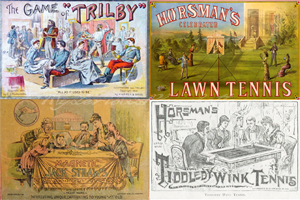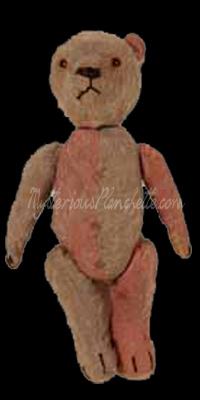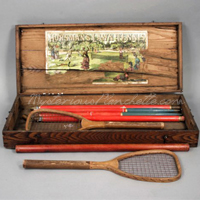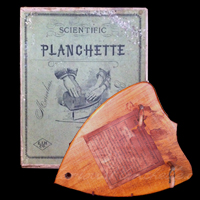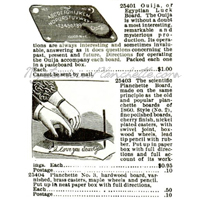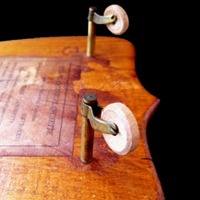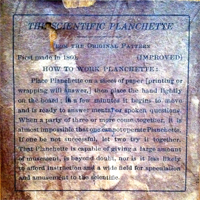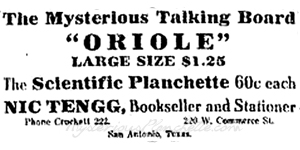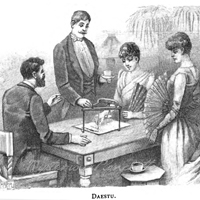What do teddy bears, creepy dolls, and planchettes have in common? Look no further than enterprising entrepreneur Edward Imeson Horsman! Born in 1843 in Brooklyn, New York, Horsman learned the import business at a young age, earning $2.00 weekly while employed by the New York importers Paton & Co. By 1865, at the ripe age of 22, Horsman was in business for himself, and importing high-quality dolls from Germany, which he assembled and sold, as well as designing and manufacturing sporting goods.
Like his British counterpart George Bussey, he took advantage of the popularity of archery, croquet, bicycling, and lawn tennis fads, selling goods to cater to fans of those fashionable leisure sports. By the late 1880s, E.I.H was producing a range of board games and boxed toys, producing such favorites as Tiddlywinks, Trilby, and Jack Straws. However, the E.I. Horsman Company was not primarily a manufacturer. Their work did consist of assembly of various parts gather from factory sources, and by the 1890s the company possessed what they called a "manufactory" in Valley Falls, Rhode Island, from where they acted primarily as distributors and agents of the manufacturer. In addition, the company maintained extensive offerings of toys, games, and sporting goods through their wholesale catalog, where they sold to retailers across the country.
While the E.I.H Company was not the first to produce Teddy Bears, it was the first to coin the phrase, shortening it to its modern form from the previously apostrophized "Teddy's Bears" in 1906. The change obviously stuck! These items, along with the high-quality dolls such at the "Can't Break 'Em!" and "Babyland Rag Dolls" that had been the lifeblood of the company since the 1870s, made a fortune for Horsman, and by the early 1900s the company was selling hundreds of thousands of the items. In addition, E.I.H produced a series of easy-to-use cameras, boasting in advertisements that "A child ten years old can make a picture." Such cameras are rare and highly-sought after collectibles today. Edward Horsman died in 1927 at the age of 83, and while Horsman Company products continued to be produced up until the 1970s, the founder's role and family's involvement with the company ceased with his death.
Given the company's history of outsourcing manufacturing, it comes as little surprise to find that E.I.H entered the planchette market by re-branding another company's product, in this case, Selchow & Righter. Unfortunately for those of us trying to pin down an actual manufacturer, Selchow & Righter also had a reputation in this period as "jobbers," in that production was typically limited to games licensed from other companies. It may be that both E.I.H and Selchow & Righter were licensing the same product from the same as-yet-unknown source, which we hope to identify with your help!
The E.I.H planks are identical in almost all respects to the more common Selchow & Righter planchettes (or is it the other way around?). The board itself is the distinctive shield shape with a pointed nose and peaked scallop to the rear, and is cut from 3-ply wood maple to a good medium thickness with nice, rounded edges. The quality of the castors is not up to the same standards, however. While they screw directly into the base of the board with a coarse thread without breaking through to the top plane, the brass wheel retainers are somewhat flimsy, holding the planchette's wooden or bakelite button wheels on only with bent finishing nails! Some examples have a brass sleeve insert serving as a pencil aperture rather than a simple hole, though many are missing this feature. Whether its absence is due to loss over the years or their lack of inclusion on all boards during manufacture is unknown, but with some specimens spotted with the sleeve replaced upside down, it is likely the piece falls out easily and becomes lost.
The label is identical in every respect to the most common labels present on Selchow & Righter planks, although there is another variation on S&R boards that has yet to be seen repeated on the E.I.H planchettes. Though the E.I.H variation does not include the maker's or agent's label, in both cases, the labels specify that the boards were "First made in 1860," though whether this is an informative nod to invention's American introduction or a claim to patent propriety is unknown. The box is identical in all respects to the "green label" Selchow & Righter boxes, with the same dimensions and illustrations, with the exception of the distinctive "E.I.H CO." diamond trademark. Comparisons with other specimens and toys of the period indicate these planchettes were most likely available in the mid-to-late 1870s, and thrived in the 1880s and perhaps into the 1890s, though there are existing advertisements for a "Scientific Planchette" in newspapers as late as 1919.
In 1891, E.I.H. introduced a new automatic writing device similar to the planchette, which the company called Daestu. This fascinating little item was a triangular wood frame that sat about 6-inches high on 3 turned-wood legs. The slightly lopsided acute triangle had one curved side that held a rod between it, and suspended from the rod was four lengths of dainty chain, from which hung a small brass plate, not unlike the pan of a scale. As the period illustrations show, the user would rest his or her wrist on the pan and relax. One supposes that the spirits would then take over the aspiring medium's writing, and answers to the sitter's questions would be answered. According to the manufacturer, it was quite successful. According to advertisements of the time, "planchette in its day was a wonder, but "Daestu" throws it far in the shade." Unfortunately, we've never encountered a surviving Daestu, but there is no doubt a specimen lingering "in the shade" somewhere, where the ouija board, introduced in the same period, undoubtedly threw it.







